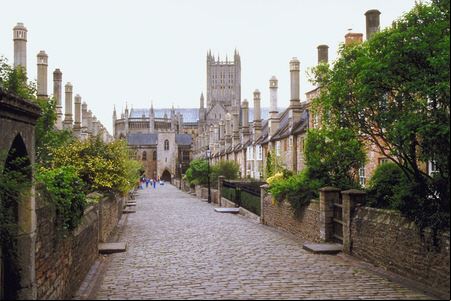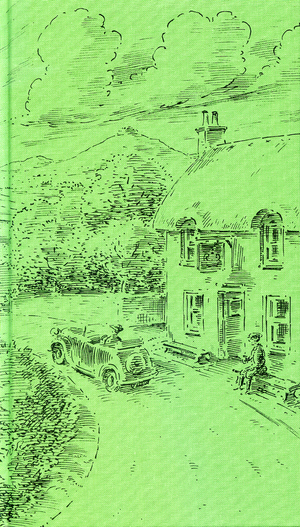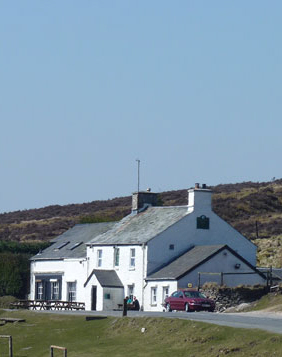
I recently received news from HV Morton Society member, Paul G, that he had managed to acquire a copy of the Strand Magazine of September 1930 (volume LXXX No 476) from an online seller. I hadn’t come across this edition before so I was delighted to be able to read pages 204 to 211, which featured an article by HV Morton, The Grand Tour of Great Britain.
It is very much of its time of course and not, perhaps, Morton’s finest work – from reading it he obviously feels constrained by the title brief and the limited word-length (he even describes as “exasperating” in the article itself!) but he does manage a helter-skelter summary of his British travel books as the reader is hauled at lightning speed from destination to destination across the country. This idea of summarising highlights from his travels was later developed in a less frenetic way in the 1970’s with the series of illustrated large format books, “HV Morton’s England”, “HV Morton’s Scotland” and so on.
I have included the text of the article below. The cover picture above is, in my humble opinion, quite magnificent! The rest of the pictures are contemporary.
§
The Grand Tour of Great Britain
by
HV Morton
Through his books and articles, Mr, H. V. Morton has been the means of introducing tens of thousands of strangers, and thousands of natives, to the peculiar fascinations of travel in Britain and Ireland. In this article he has summarized for the benefit of the intending tourist his impressions of those places that no intelligent traveller can afford to miss.
I.
ONE of the healthiest tendencies of this age is the interest which men and women in Great Britain are taking in the history, the archaeology, and the scenery of their own land. The cheap motor-car and the excellent road transport services which have developed since the War are largely responsible. Go where you like to-day and you will encounter people who are exploring their own country with an intelligent zest which previous generations reserved for France, Italy, and Switzerland.
I receive letters from every part of the world asking if I will outline the perfect tour of Great Britain. I welcome those from Canada, Australia, New Zealand, and the United States, but I rather regret those from people living in this country. It seems to me so strange, that- anyone should deny himself the exquisite pleasure of taking a map and a guide-book and plotting his own route. But the fact remains that thousands of would-be explorers lack the initiative to dive off into England and find their own way, therefore some guidance, it seems, is essential.
Your perfect tour of Great Britain begins at home in an arm-chair with a book like G. M. Trevelyan’s “ History of England.” You cannot appreciate England until yon have brushed up your history. You should follow this with a popular book on geology.
The structure of the earth has determined the events of history; it has also affected the appearance of the landscape. If everyone who travels in England studied geology and realized how perfect is the native architecture, and how it varies from formation to formation, public opinion might perhaps be strong enough to prevent reckless and apparently- uneducated architects from planting timber buildings in stone country and stone buildings in timber country. They do even worse things than this !
I consider that a tour of any country should begin from its capital: London, Edinburgh, and Dublin, in the present instance. I would send my traveller from London to Dover. These white cliffs are the first glimpse of England in history. I would let him find his way, preferably via Rye and Winchelsea, to Winchester. I would like him then to explore the New Forest. He might stay at Brockenhurst or Beaulieu, or, if he does not mind modest accommodation, in that queer, haunted village overlooking Beaulieu River, Bucklers Hard. There they used to build wooden warships. The slipways are rotting and the wide village street ends as if cut with a knife. Only a few cottagers now live in a place which two centuries ago attempted to challenge the supremacy of Portsmouth.
The motorist should run down to Christchurch and Bournemouth from the New Forest and then go north to Salisbury. Every cathedral in England has one supreme feature. Salisbury’s pride is its spire. Stonehenge is only a few miles away. It is well worth while to get up in the early dawn to see Stonehenge.
 A Portland Quarry – now abandoned
A Portland Quarry – now abandoned
Now the road goes west into Dorset. Weymouth is still a Georgian watering place. The traveller will say—as everyone says in sunny weather—that the bay is rather like that of Naples. But no one should go to Weymouth and leave the Isle of Portland unvisited. This great stone quarry from which all Wren’s City churches were hewn has provided material for many of the greatest buildings in the world. It is fascinating to wander beside the sea in those colossal excavations from which St. Paul’s Cathedral was taken. You will discover two pillars overgrown with brambles which for some reason or other never found their way to Ludgate Hill. And in another quarry they will show you a long trough. The great stone hewn from this quarry is now the Cenotaph.
The traveller will now take the road into the glorious county of Devon. He will admire Torquay with its red soil and go on to Plymouth. Plymouth, especially its fish market and the Barbican, will repay any amount of loitering; and at dusk there is only one place to go—the finest promenade in Europe, Plymouth Hoe.
The change from Devon into Cornwall is one of the remarkable experiences in a country which is full of quick changes in atmosphere. Cornwall is Celtic. It looks like it and sounds like it. Round Falmouth and St. Mawes are some of the most glorious villages in the country. Land’s End is a fascinating place. I would like my traveller to see it on a day of sea mist when the minute-gun is booming in the greyness and the waves are breaking in white foam over the sharp, black rocks. The run up the west coast of Cornwall is enchanting. Everyone should see Tintagel. It is one of the most romantic names on the map of England, and if you climb up to Arthur’s Castle at evening by yourself and hear no sound but sheep cropping grass on the queerly-shaped mounds you will not have travelled in vain.
Once more comes Devon with its varied fields and its cosy villages : Clovelly perched on its cliffs ; Bideford, Barnstaple ; Lynton and Lynmouth (which, like Clovelly, are professional beauties), and then that magnificent few miles beside the sea over the cliffs to Porlock.
 Cathedral Close, Wells
Cathedral Close, Wells
Wells, Bath, and Bristol should be explored. Wells is in many ways one of the most fascinating cathedral cities in the country, Bath is a delightful quiet old lady with, it is difficult to realize, a past, and Bristol is a city in which any man with an eye for history could spend weeks.
Now come those three lovely sisters among English counties : Gloucestershire, Worcestershire, and Herefordshire. Their three cathedrals should be studied. Cheltenham, Stratford-on-Avon, and Coventry are not far off. If you want an amusing experience, go to Droitwich and try to establish your balance in that salt brine which turns the human body into cork. You can sit upright in this water and paddle round with your hands.
From Hereford go to Ludlow and Shrewsbury and enjoy the still faintly war-like atmosphere of the Marches. There is something about this district rather like that of the Scottish Border. Then Chester with its wall, and northward to Lancaster and the Lake District. The traveller now finds himself in wild and beautiful country. The softness of Devon and Somerset seems like a dream. He becomes conscious that Scotland is over the sky-line.
Now comes the Roman Wall. The eighty miles from Carlisle across England to Newcastle are among the most fascinating and romantic in England. Midway is Chesters, with its Roman Cavalry station. You can see the marks of the chariot wheels on the stones. You should leave the road and follow the great wall of Hadrian for miles. It runs on straight as a sword, the northern boundary of the ancient world.
Newcastle will perhaps not hold the traveller for long, although its Norman castle is interesting and not as well known as it should be. Durham is the city ! The first sight of Durham Cathedral on its hill is one of the unforgettable things in England. This cathedral is almost too good to be true. It is one of the grandest Norman monuments in the world.
Now follows a district which is as full of beauty and interest as the West Country and the green Midlands. It is the splendid county of Yorkshire, a country in itself, a great area which combines every characteristic of English scenery, from the flat plain of York, which reminds you of Herefordshire lowlands, to the high cliffs of Flamborough, which remind you of Cornwall. You come south from Durham to Ripon, where they have been blowing a horn in the market-place at curfew-time since Saxon days, and to Harrogate, the brightest and most cheerful of all spas. To the west you have the glories of Wharfedale and to the east the wildness of the moors leading to pretty Whitby and prosperous Scarborough. You have the superb abbeys of Fountains, Rievaulx, and Jervaulx. But the greatest glory of the North is the City of York. Here a man can idle weeks away and find some new beauty every hour.
The traveller now goes south to Lincoln and to the strange, attractive lowlands of the Wash. Here he might be in Holland. Boston, with its famous “ Stump,” looks as if it had been blown over from the Continent. Then come Peterborough, King’s Lynn, Wells-next-the-Sea, Cley—those wonderful little stranded sea-coast towns from which the sea has retreated—and that beautiful and neglected cathedral city, Norwich. East Anglia is another of those districts in England which the traveller groups in his mind as an area distinct and remarkable as the West Country, the Lakes, the Midlands, and the North. It has a character of its own. It is gentle, flat country full of a quiet charm.
Ely, Cambridge, Colchester, and the Constable Country, and then back to London. That is the brief outline of a tour which should serve very well as a beginning. It should at least enable a traveller to focus the country in his mind. It will certainly whet his appetite and provide him with sufficient hobbies to last more than one lifetime !
II.
Scotland, is an easy country to tour. I like to enter Scotland on the east Border at Carter Bar and move up to Edinburgh through that part of the Lowlands associated for ever with Walter Scott. You have here a group of ruins equivalent to the abbeys of Yorkshire—Jedburgh, Kelso, and Melrose. Near Melrose is Abbotsford.
It is exasperating to be forced to dismiss Edinburgh in a phrase. Here is a city of cities. It sits on its rock like an armoured knight. Old Edinburgh is mediaeval; New Edinburgh is stylishly Georgian. Holyrood is full of memories of Mary Queen of Scots and Prince Charles Edward; the Castle has its roots far deeper in Scotland’s history.
From Edinburgh the traveller should go north to Stirling. The view from the ramparts of Stirling Castle towards the Highlands is one of the supreme views in Great Britain. The route now runs through Dunfermline into the distinct little “ Kingdom ” of-Fife : St. Andrews, which I suppose all golfers-must see, Perth, a fascinating city, and. then a grand good-bye to flat country and a climb up from Blairgowrie over the Devil’s Elbow to the picture-postcard Highlands of Braemar, Balmoral; Ballater, to Aberdeen.
A glorious day’s motoring is that from Aberdeen to Inverness via Elgin and Nairn. Inverness is, in its unique way, as striking as Edinburgh. You are in the capital of Gaelic Scotland and you are reminded of this at every corner. From the castle ramparts at evening you look south-west into a magic land of blue mountains and silver lochs.
I think the journey beside the so-called Caledonian Canal is one of .the finest in Europe. Half-way is Fort Augustus, which was built in the eighteenth century to subdue the last wild men of Europe, the Highlanders, and at the end of the journey is that delightful Highland town Fort William, with Ben Nevis towering up behind it. I would like my traveller to climb the Ben as I did once, on a brilliant autumn day which gradually grew colder and colder until at the top I entered a snowstorm that chilled the very marrow in my bones.
 Ben Nevis
Ben Nevis
From Fort William to the west is that wonderful country of stern mountain and loch associated with Bonnie Prince Charlie. It leads to the Kyle of Lochalsh and a little boat to Skye. This island is enchanted. It would be a tragedy to visit Scotland and fail to see the Coolins, the, strangest mountains in Europe, or Glen Sligachan, that leads, over miles of barren country to Loch Coruisk, which on a sombre day is like an overture by Wagner.
Returning to the mainland, the route now runs from Fort William through the gloomy pass of Glencoe to Oban and Inveraray. Then come Loch Lomond and Glasgow. Everyone should hire a boat and sail up the Clyde from, say, Greenock. South of Glasgow, balancing the Scott country of the east Border, is that district sacred to Burns—Ayr, Dumfries, and then, over the Border, Carlisle.
This is a tour that may help those who are visiting Scotland for the first time. I could amplify it enormously. I hope that if anyone follows it he will depart from the route as often as possible and make his own discoveries, especially from Inverness and the Kyle of Lochalsh.
III.
Ireland, like Scotland, is easy to see. The high lands are round the coast and the centre of the country is a huge and difficult bog. When the traveller has enjoyed the peculiar charm, of Dublin I suggest that he should work to the south through Tipperary. He should make for Cashel with its supreme ruins. Cormac’s Chapel is the most beautiful Gaelic ruin in the world.
He should then go to Cork, kiss the Blarney Stone, and stay at Glengariff, which is an Irish Riviera. The whole of Kerry is steeped in a melancholy beauty. It is a place of wild, barren hills and incredibly beautiful coast scenery. Killamey is, of course, an inevitable destination. The lakes are magnificent and the country round about is supreme of its kind. A place slightly off the beaten track is Valentia. In good weather it is a journey well worth taking.
But the part of Ireland which fascinates me is Connemara. If the traveller goes north from Killarney through Limerick to Galway he will enter a country as primitive as any in Europe. This is the Gaelic Ireland of literature. This is the Ireland of the Gaelic League, Synge, Yeats, and “ A. E.” When you take the road north from Galway the modern world seems to have come to an end. Barefoot girls in scarlet petticoats sit sideways on diminutive donkeys. There is the reek of peat in the air. Peasants, many of whom speak only the Gaelic, rake up the seaweed and spread it on their potato patches. The fishermen go out to sea in coracles as primitive as those of the ancient Britons. These queer craft—skins stretched over a framework—are to be seen tilted against the white walls of the little cabins.
The traveller who wishes to enjoy this primitive country should stay for some time at Clifden before moving on to the slightly more sophisticated county of Mayo, where at Mallaranny he will encounter one of the incredible views in Great Britain. On certain days the mountains of the west coast are washed in an indescribable colour known as “ Atlantic blue.” You see this colour sometimes on the west coast of Scotland, but never in my experience is it so wonderful as in Mayo. Connected with the mainland by a small bridge is the Isle of Achill, where the dogs still go mad at the sight and sound of a motor-car. Here life is as primitive as in Connemara. Every young person in Achill goes off in the season to pull potatoes in Scotland or the North of England.
The route then takes the traveller northward through Sligo into Donegal. Then come Londonderry and the Ulster border. Ulster might be Scotland. The great sight is, of course, the Giant’s Causeway. Belfast should be visited and compared with Dublin. It is difficult to imagine two cities more widely different from one another. Southward the road takes one over the boundary into the Free State. There is the town of Drogheda and, eventually, Dublin.
This circuit of Ireland is a simple tour. I think anyone who makes it will agree with me that Kerry and Connemara are the districts that remain for ever in the memory. Here you have a mediaeval point of view and a way of life that has not changed in its essentials from, the life of our tribal ancestors.
Originally circulated as HVM Society Snippets – No.238 on 1st June 2019




